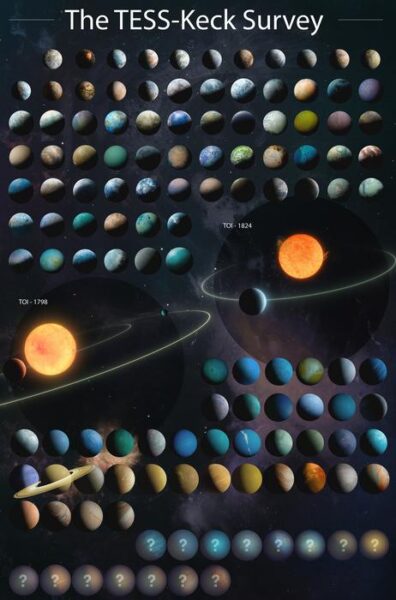In a comprehensive study, a large, international team of scientists has analyzed 126 newly discovered exoplanets using NASA’s Transiting Exoplanet Survey Satellite (TESS) in collaboration with the W.M. Keck Observatory on Maunakea, Hawai’i. The findings, published in The Astrophysical Journal Supplement, shed light on the diverse nature of planetary systems and their potential for hosting life.
Measuring Mass and Radius: The Key to Understanding Exoplanets
The TESS-Keck Survey catalog, developed over three years, provides detailed measurements of both the mass and radius of 120 confirmed planets and six candidate planets. “Relatively few of the previously known exoplanets have a measurement of both the mass and the radius. The combination of these measurements tell us what the planets could be made of and how they formed,” explained Stephen Kane, UC Riverside astrophysicist and principal investigator of the survey.
By analyzing more than 13,000 radial velocity measurements, the researchers were able to detect the “wobble” of host stars caused by the gravitational tug of orbiting planets. This Doppler effect, similar to the changing pitch of a fire truck’s siren as it moves closer or farther away, allows astronomers to infer the presence and properties of exoplanetary systems.
Touchstones for Understanding Planet Formation and Evolution
Several planets in the TESS-Keck Survey stand out as key examples for deepening our understanding of the diverse ways planets form and evolve. UCR graduate student Michelle Hill announced the discovery of two new planets orbiting a sun-like star, including a “sub-Saturn” planet with a mass and radius between those of Neptune and Saturn. “There is ongoing debate about whether sub-Saturn planets are truly rare, or if we are just bad at finding planets like these,” Hill said. “So, this planet, TOI-1386 b, is an important addition to this demographic of planets.”
Another survey paper, authored by UCR graduate student Daria Pidhorodetska, describes a planet about half the size of Neptune that takes only 19 days to orbit its sun-like star. “Planets smaller than Neptune but larger than Earth are the most prevalent worlds in our galaxy, yet they are absent from our own Solar System. Each time a new one is discovered, we are reminded of how diverse our Universe is, and that our existence in the cosmos may be more unique than we can understand,” Pidhorodetska said.
The catalog also details planets with extreme, ultra-short orbits around stars unlike our sun, including one that completes its orbit in less than 12 hours. “TOI-1798 c orbits its star so quickly that one year on this planet lasts less than half a day on Earth. Because of their proximity to their host stars, planets like this one are also ultra hot — receiving more than 3,000 times the radiation that Earth receives from the sun,” explained Alex Polanski, University of Kansas physics and astronomy graduate student and lead author of the catalog paper.
Ultimately, this new catalog represents a major contribution to NASA’s TESS mission and the ongoing quest to determine whether other planets are capable of hosting life as we know it. “Are we unusual? The jury is still out on that one, but our new mass catalog represents a major step toward answering that question,” Kane said.


